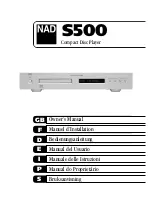
G0677 24" Planer/Sander
-43-
Brake Service
Tools Needed:
Qty
Open End Wrench 14mm .................................. 1
Snap Ring Pliers Small ..................................... 1
Hex Wrench 6mm .............................................. 1
Phillips Screwdriver #2 ...................................... 1
C-Clamp 8" ........................................................ 1
Checking Brake Pads
1.
DISCONNECT THE PLANER/SANDER
FROM THE POWER SOURCE AND
REMOVE AIR PRESSURE COMPLETELY
!
2. Unlock and open the lower right access
door.
3. The brake pads consist of a metal plate with
a composite pad. Using a fine ruler, measure
the thickness of the composite pad only.
Eventually the brake pads will wear out. Checking
and replacing these is a simple procedure that
can be done in the shop, with the exception of
having the rotor resurfaced on a lathe.
The brake
pads are located underneath the rotor as shown in
Figure 48, which is attached to the motor arbor.
Figure 48. Disc brake assembly.
Anchor Pins
—If one of the pads is less than
1
⁄
8
" (
Figure
49
) (approximately 3mm), replace both.
Figure 49. Example of brake caliper removed for
access to brake pads.
1
⁄
8
"
Min
Replacing Brake Pads
1.
DISCONNECT THE PLANER/SANDER
FROM
THE
POWER
SOURCE
AND DISCHARGE AIR PRESSURE
COMPLETELY
!
2. Remove the nuts and washers from the two
anchor pins on each brake caliper (
Figure
48).
3. Remove the anchor pins, springs, and air line
from the caliper bracket. Now, remove the
caliper.
4. Disassemble the brake caliper and remove
the screws that secure the brake pads.
5. Remove the brake rotor and have it profes-
sionally resurfaced at an automotive machine
shop if it has gouges in it. If visible cracks are
present in the brake rotor, replace it with a
new one. Remove oil and dirt from the rotor
with automotive brake cleaner. Once clean,
only handle the rotor with a dry rag and
install exactly the reverse of removal. Use a
C-clamp to compress the piston back into the
caliper.
6. Install new brake pads, mount the caliper
assembly by reversing
Steps 2-4,
and recon-
nect the air line.
7. Test the emergency stop system to make
sure the brake works.
Brake
Pads
5. Re-tighten the mounting bolts.
6. Push the up arrow key
and raise the table
until it is
1
⁄
8
" below the sanding drum.
7. Loosen the limit switch bolts and move the
switch so the plunger depresses against the
stop block and you hear the switch click (see
Figure 47), then tighten the bolts.
8. Repeat Step 3 and readjust if necessary.
















































